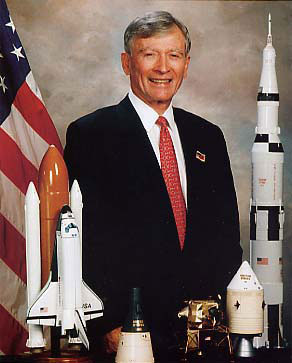
[an error occurred while processing this directive]

Today@Sam | Headlines | Calendar | Experts | Notices | Archives | Search
Astronaut John Young
Is Fall Distinguished Lecturer
 |
John Young, one of America's first astronauts and one of its most accomplished, has been there, done that. He stays ready to fly again if given the chance, but his job these days is also to warn about the "bad events" that threaten to one day destroy humankind.
"NASA is not about the 'Adventure of Human Space Exploration,' says Young, who is associate director of the Johnson Space Center south of Houston. "We are in the deadly serious business of saving the species."
Invited guest John Young will bring his concerns to the Sam Houston State University campus Oct. 9, as the fall semester's Distinguished Lecturer. His presentation is scheduled for 8 p.m. in the Beto Criminal Justice Center Killinger Auditorium. He follows previous Distinguished Lecturers who, since the program's inception in 1980, have included former President George Bush, Polish President Lech Walesa, historian Arthur Schlesinger, economist John Kenneth Galbraith, and others.
Young is a true hero of the United States Space program. He and Gus Grissom were aboard Gemini 3, the first manned Gemini mission in March 1965. On Apollo 10 in May 1969, he orbited the Moon and tracked sites for Neil Armstrong and Buzz Aldrin's historic landing and steps two months later.
In April 1972, he and Charlie Duke landed on the Moon in the lunar highlands at Descartes, collected 200 pounds of rocks and drove over 16 miles in the lunar rover on three separate geology traverses. In April 1981, he was spacecraft commander of the first flight of a Space Shuttle, a highly risky mission since all previous U. S. space vehicles had first been tested unmanned.
His sixth and last flight was as spacecraft commander of the first Spacelab mission, for 10 days in November/December of 1983, which produced more scientific and technical data than all previous Apollo and Skylab missions combined.
This September 24 John Young will be 71. He would like to go back into space, and many advocate that he be given that opportunity. But these days he attends to his Johnson Space Center duties, travels the world as NASA's most accomplished active astronaut, and warns of the "bad events" that are almost certain to eventually happen to Earth and its inhabitants.
He is concerned about three possible "bad events" that could change the Earth and humankind as we know it forever, making it necessary for a few true space pioneers to take life to the Moon, Mars, or elsewhere, to survive and start anew. These might include sunspot decline, volcanic activity, and asteroid/comet impacts.
In material he has published Young cites the effect of Mount Pinatubo, that produced 8 cubic kilometers of ash, on the worldwide temperature between 1991 and 1993, temporarily lowering it one degree.
Geologists know of past eruptions of volcanoes producing 1,000 to 2,800 cubic kilometers of ash, and such eruptions are expected to eventually happen again. Such an eruption might lower temperatures drastically, causing tens of millions of humans to starve.
The expected result of the impact of a large asteroid could range from the extinction of species, including humans, to a non-extinction event in which perhaps one-quarter of the Earth's population would die.
The key to avoiding that "bad event" is detection of an impact-bound asteroid, and the ability to intercept it and either destroy it or alter its course.
Young knows what has to be done to live and work on the Moon and Mars. Concerns include power and food production, closed loop environments in which everything humans eat, drink and breathe is recycled, transportation to get there, propellants and pressure suits.
The challenge now for Young and others who advocate the continuation of space exploration by humans is how to overcome ignorance and apathy.
"The last 25 years of NASA's Solar System exploration including Earth is telling us what we need to do to preserve our species," Young has written. "This new knowledge is useless unless we act on it."
- END -
SHSU Media Contact: Frank Krystyniak
Sept. 5, 2001
Please send comments, corrections, news tips to Today@Sam.edu
This page maintained by SHSU's Office of Public Relations
Director: Frank Krystyniak
Communications Coordinator: Julia May
Located in the SHSU University Advancement Building
Telephone: 936.294.1836; Fax: 936.294.1834
